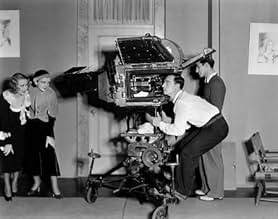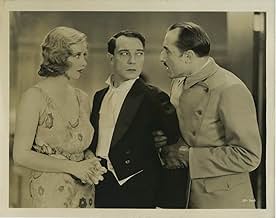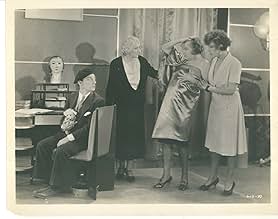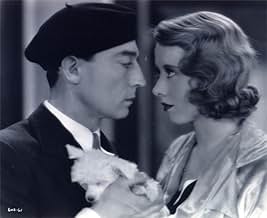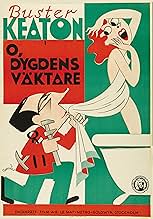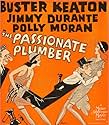Ajouter une intrigue dans votre langueTo make her lover jealous, a beautiful socialite passes off a bumbling plumber as her paramour.To make her lover jealous, a beautiful socialite passes off a bumbling plumber as her paramour.To make her lover jealous, a beautiful socialite passes off a bumbling plumber as her paramour.
- Réalisation
- Scénario
- Casting principal
- Récompenses
- 4 victoires au total
Edward Brophy
- Man Outside Beauty Parlor
- (non crédité)
Heinie Conklin
- Hunter with Rifle at Duel
- (non crédité)
Carl M. Leviness
- Casino Patron
- (non crédité)
Fred Malatesta
- Tony's Second
- (non crédité)
Rolfe Sedan
- Tony's Second
- (non crédité)
Stanhope Wheatcroft
- Casino Patron
- (non crédité)
Florence Wix
- Casino Patron
- (non crédité)
Avis à la une
This movie marks the darkest period for Buster Keaton and his fans. While the transition to sound for Keaton was very poor (after all, MGM studios tried to make this great mime a talking star), the PASSIONATE PLUMBER marks the beginning of the end of Keaton's career. That's because this was the first of three films that paired Keaton with Jimmy Durante--a "comedian" whose style was the exact opposite of Keaton's. Keaton's humor was physical and sweet, while Durante was extremely loud and overbearing and the two styles meshed like oil and water. It was obvious that the execs at MGM had no idea what to do with Keaton and pairing him with Durante was a sign that they had "jumped the shark"--in other words, they were trying desperate measures to try to salvage a career that had already peaked.
Now this isn't to say that Keaton couldn't have been funny. Had his films remained true to his strengths (physical humor and a general likability), he could have remained a viable star. Chaplin did this by refusing to immediately switch to sound films--making CITY LIGHTS (1931) and MODERN TIMES (1936) as silent movies even when everyone had switched to sound long before these films. It's really too bad that MGM didn't do what they did with Laurel and Hardy. This team did work for MGM technically speaking, but MGM allowed the affiliated Hal Roach Studio almost complete independence to do what they knew how to do best. Perhaps if Keaton had been sent to Roach, his sound career would have been a success. But with the gag writers at MGM, he was sunk.
This film is worse than his previous sound outings because Keaton is given almost no physical gags at all. The few that he does have are among the best moments in the film because they are genuine--gags that suit Keaton's style. But the rest of the film is so talky and forgettable that it will most likely make Keaton fans (like myself) wince. And, while I know some Durante fans might take offense, he came off as just obnoxious and annoying!
The film is called the PASSIONATE PLUMBER, though Keaton spends very little time plumbing. The beginning of the film involves more scenes with Durante and Keaton--while the last half of the film they don't appear in that many scenes together (thank goodness). During this phase of the film, Keaton mostly annoys those around him and is invited to a series of duels due to his incessant and annoying bumbling. For the remainder of the film, he tags along with a young woman as her aide. She has gotten him to promise never to leave her side because she's afraid she'll lose control and allow Gilbert Rolland to make love to her. So, through over half the film, you see Keaton essentially following her and that's all there is to the plot.
Sadly throughout all of this, there are almost no laughs at all--a serious problem with a comedy! Only at the very end, when it degenerates to slapstick, does the film show any promise--but then the final credits roll and you are left thinking "is that all there is?".
Now this isn't to say that Keaton couldn't have been funny. Had his films remained true to his strengths (physical humor and a general likability), he could have remained a viable star. Chaplin did this by refusing to immediately switch to sound films--making CITY LIGHTS (1931) and MODERN TIMES (1936) as silent movies even when everyone had switched to sound long before these films. It's really too bad that MGM didn't do what they did with Laurel and Hardy. This team did work for MGM technically speaking, but MGM allowed the affiliated Hal Roach Studio almost complete independence to do what they knew how to do best. Perhaps if Keaton had been sent to Roach, his sound career would have been a success. But with the gag writers at MGM, he was sunk.
This film is worse than his previous sound outings because Keaton is given almost no physical gags at all. The few that he does have are among the best moments in the film because they are genuine--gags that suit Keaton's style. But the rest of the film is so talky and forgettable that it will most likely make Keaton fans (like myself) wince. And, while I know some Durante fans might take offense, he came off as just obnoxious and annoying!
The film is called the PASSIONATE PLUMBER, though Keaton spends very little time plumbing. The beginning of the film involves more scenes with Durante and Keaton--while the last half of the film they don't appear in that many scenes together (thank goodness). During this phase of the film, Keaton mostly annoys those around him and is invited to a series of duels due to his incessant and annoying bumbling. For the remainder of the film, he tags along with a young woman as her aide. She has gotten him to promise never to leave her side because she's afraid she'll lose control and allow Gilbert Rolland to make love to her. So, through over half the film, you see Keaton essentially following her and that's all there is to the plot.
Sadly throughout all of this, there are almost no laughs at all--a serious problem with a comedy! Only at the very end, when it degenerates to slapstick, does the film show any promise--but then the final credits roll and you are left thinking "is that all there is?".
I have never seen nor want to see a silent Buster Keaton film so came to this without any preconceptions or anti-talkie prejudice. To me this very much has the feel of a Laurel and Hardy picture. Well made silly gentle slapstick.
When you read that this was adapted from a stage play, you're right to approach with caution but you don't need to worry about this. It's not one of those awful filmed stage plays - this was properly adapted into a proper film with a cinematic rather than a theatric script.
If you're ok with the somewhat acquired taste of American 1930s comedy acting and like Stan and Ollie, you'll probably enjoy this. Unlike many early thirties comedies, the characters are, although not realistic, actually engaging. You're interested in them, you want to know what happens to them. So often that acting style creates characters so unbelievable that you can't accept them as real people. The protagonists here however, like you find in L&H films, manage that perfect balance of absurdly with likeability.
Buster Keaton purists don't like this - it's not their Buster! Like when The Marx Brothers went to MGM and became what MGM wanted them to be, Buster Keaton became Thalberg's neutered befuddled pet. I've no problem with that. As a stand alone picture, to someone who doesn't watch silent movies, this Buster is perfect for a film like this.
His co-star is the acclaimed stage actress Irene Purcell and like Keaton, she is perfect in this too. It was, and still is rare to find an actress in the movies who is allowed be genuinely as funny as the male comedian, not just his pretty foil. She completely captures your attention and that's not just because she's so stunningly and staggeringly attractive, she has real comedy talent and this picture allows her to demonstrate this without the usual constraints of the time.
When you read that this was adapted from a stage play, you're right to approach with caution but you don't need to worry about this. It's not one of those awful filmed stage plays - this was properly adapted into a proper film with a cinematic rather than a theatric script.
If you're ok with the somewhat acquired taste of American 1930s comedy acting and like Stan and Ollie, you'll probably enjoy this. Unlike many early thirties comedies, the characters are, although not realistic, actually engaging. You're interested in them, you want to know what happens to them. So often that acting style creates characters so unbelievable that you can't accept them as real people. The protagonists here however, like you find in L&H films, manage that perfect balance of absurdly with likeability.
Buster Keaton purists don't like this - it's not their Buster! Like when The Marx Brothers went to MGM and became what MGM wanted them to be, Buster Keaton became Thalberg's neutered befuddled pet. I've no problem with that. As a stand alone picture, to someone who doesn't watch silent movies, this Buster is perfect for a film like this.
His co-star is the acclaimed stage actress Irene Purcell and like Keaton, she is perfect in this too. It was, and still is rare to find an actress in the movies who is allowed be genuinely as funny as the male comedian, not just his pretty foil. She completely captures your attention and that's not just because she's so stunningly and staggeringly attractive, she has real comedy talent and this picture allows her to demonstrate this without the usual constraints of the time.
THE PASSIONATE PLUMBER (Metro-Goldwyn-Mayer, 1932), a Buster Keaton production directed by Edward Sedgwick, stars Buster Keaton in his second "farce" comedy, the first being PARLOR, BEDROOM AND BATH (MGM, 1931). With screen adaptation by Laurence E. Johnson, and uncredited material lifted from the play "Her Cardboard Lover" by Jacques Deval, THE PASSIONATE PLUMBER, its new title, certainly improves over Keaton's previous screen sound efforts for MGM (1930-33). Though not quite a cinematic masterpiece as one could have hoped for, it's basic flaws tend to be placed on certain gag and story material as being undeveloped with resolutions left unresolved. Overlooking these minor aspects, the finished product generally blends in nicely with its basic comedy premise, even for Keaton.
Set in Paris, France, with the Arch of Triumph captured in full view for its opening, the story introduces Julius J. (J. for Julius) McCracken (Jimmy Durante) coming to Paul Le Maire's (Paul Porcasi) shop in need of a plumber for his employer to fix a leak in the shower. Julius gets Elmer E. (E. for Elmer) Tuttle (Buster Keaton wearing beret), an American from Yonkers, working on his latest experiment, a spot shooting pistol. After these strangers get introduced, next scene has Elmer escorted into the mansion of socialite Patricia Alden (Irene Purcell) where he goes to work on her shower. In the meantime, plot development introduces Alhine (Polly Moran), the household maid whom McCracken is crazy about, and how much Miss Alden is crazy about Tony Lagorce (Gilbert Roland), a handsome gigolo, whose Spanish speaking wife, Nina (Mona Maris), refuses to grant him a divorce. Unaware to Miss Alden, Tony is actually carrying on a romance with Nina, using Patricia as his excuse for a wife, too, refusing to grant him a divorce. Hoping to make Tony jealous, Patricia hires Elmer as her lover decoy, or better yet, her passionate plumber, resulting to a series of mishaps for all concerned.
Previously filmed at the tail-end of the silent era as THE CARDBOARD LOVER (MGM, 1928) starring Marion Davies,and Nils Asther, and remade again as HER CARDBOARD LOVER (MGM, 1942) starring Norma Shearer and Robert Taylor, the Keaton carnation proves most interesting due to how its writers revamped a sophisticated comedy to fit with the opposite comedic talents of deadpan Keaton and over zealous Durante. Though their characters start off as complete strangers, only minutes into the story does it give the impression of they being lifelong pals. Even before the store comes to the halfway mark is it forgotten that Keaton's character is a plumber. It's a wonder if he ever got to finish fixing the shower and make up the bill for his time?
Of the several comedy highlights, including Keaton's gambling mishap at the Casino de Paris and the gigolo's attempt of keeping his two mistresses from getting together, the best known and/or most admired happens to be the dueling sequence between Keaton and Roland, with Durante in amiable support. Though it has its moments, it's obvious how this burlesque style pistol dueling would be recycled by future comedians as Bob Hope, Danny Kaye, or even one of the Three Stooges as prime examples. Keaton's frequent glove slapping Frenchmen to duels and correcting those who constantly mispronounce his last name, along with Mona Maris' constant Spanish speaking outbursts (done more favorably by Mexican actress Lupe Velez in later years) to Mexican born Gilbert Roland in saying in her accented English, "If you could only speak Spanish," are agreeable run-on gags. It's also a wonder how Velez might have handled such similar scenes had she been selected to play the spitfiring wife instead of Maris?
Others featured in the cast are Maude Eburne (Aunt Charlotte); Henry Armetta, Jean Del Val and Edward Brophy (Keaton's frequent co-star during his MGM years) in a cameo appearance as the man outside the beauty parlor. Irene Purcell, a not so well known actress with so few movies to her credit, makes an acceptable foil for Keaton's buffoonery. Closely resembling Joan Blondell in physical appearance and Genevieve Tobin in both mannerism and speech, she takes part in some good scenes involving Keaton, one where she gets served breakfast in bed (in the silent film tradition with limited dialog), and another where she constantly tries losing him so she can have a secret meeting with her lover. Polly Moran, better known for her screen partnership opposite Marie Dressler, has some funny bits here, too, few and far between, but mostly with Durante.
As much as Keaton and Durante are as compatible as Stan Laurel and Harpo Marx, MGM would pair them again in SPEAK EASILY (1932) and WHAT, NO BEER! (1933) before ending their screen partnership. Virturally forgotten over the years, this and other Keaton MGM comedies can be seen and studied whenever broadcast on cable television's Turner Classic Movies. Keaton's Elmer may not be the greatest plumber in Paris, but certainly is passionate, in a funny sort of way. (***)
Set in Paris, France, with the Arch of Triumph captured in full view for its opening, the story introduces Julius J. (J. for Julius) McCracken (Jimmy Durante) coming to Paul Le Maire's (Paul Porcasi) shop in need of a plumber for his employer to fix a leak in the shower. Julius gets Elmer E. (E. for Elmer) Tuttle (Buster Keaton wearing beret), an American from Yonkers, working on his latest experiment, a spot shooting pistol. After these strangers get introduced, next scene has Elmer escorted into the mansion of socialite Patricia Alden (Irene Purcell) where he goes to work on her shower. In the meantime, plot development introduces Alhine (Polly Moran), the household maid whom McCracken is crazy about, and how much Miss Alden is crazy about Tony Lagorce (Gilbert Roland), a handsome gigolo, whose Spanish speaking wife, Nina (Mona Maris), refuses to grant him a divorce. Unaware to Miss Alden, Tony is actually carrying on a romance with Nina, using Patricia as his excuse for a wife, too, refusing to grant him a divorce. Hoping to make Tony jealous, Patricia hires Elmer as her lover decoy, or better yet, her passionate plumber, resulting to a series of mishaps for all concerned.
Previously filmed at the tail-end of the silent era as THE CARDBOARD LOVER (MGM, 1928) starring Marion Davies,and Nils Asther, and remade again as HER CARDBOARD LOVER (MGM, 1942) starring Norma Shearer and Robert Taylor, the Keaton carnation proves most interesting due to how its writers revamped a sophisticated comedy to fit with the opposite comedic talents of deadpan Keaton and over zealous Durante. Though their characters start off as complete strangers, only minutes into the story does it give the impression of they being lifelong pals. Even before the store comes to the halfway mark is it forgotten that Keaton's character is a plumber. It's a wonder if he ever got to finish fixing the shower and make up the bill for his time?
Of the several comedy highlights, including Keaton's gambling mishap at the Casino de Paris and the gigolo's attempt of keeping his two mistresses from getting together, the best known and/or most admired happens to be the dueling sequence between Keaton and Roland, with Durante in amiable support. Though it has its moments, it's obvious how this burlesque style pistol dueling would be recycled by future comedians as Bob Hope, Danny Kaye, or even one of the Three Stooges as prime examples. Keaton's frequent glove slapping Frenchmen to duels and correcting those who constantly mispronounce his last name, along with Mona Maris' constant Spanish speaking outbursts (done more favorably by Mexican actress Lupe Velez in later years) to Mexican born Gilbert Roland in saying in her accented English, "If you could only speak Spanish," are agreeable run-on gags. It's also a wonder how Velez might have handled such similar scenes had she been selected to play the spitfiring wife instead of Maris?
Others featured in the cast are Maude Eburne (Aunt Charlotte); Henry Armetta, Jean Del Val and Edward Brophy (Keaton's frequent co-star during his MGM years) in a cameo appearance as the man outside the beauty parlor. Irene Purcell, a not so well known actress with so few movies to her credit, makes an acceptable foil for Keaton's buffoonery. Closely resembling Joan Blondell in physical appearance and Genevieve Tobin in both mannerism and speech, she takes part in some good scenes involving Keaton, one where she gets served breakfast in bed (in the silent film tradition with limited dialog), and another where she constantly tries losing him so she can have a secret meeting with her lover. Polly Moran, better known for her screen partnership opposite Marie Dressler, has some funny bits here, too, few and far between, but mostly with Durante.
As much as Keaton and Durante are as compatible as Stan Laurel and Harpo Marx, MGM would pair them again in SPEAK EASILY (1932) and WHAT, NO BEER! (1933) before ending their screen partnership. Virturally forgotten over the years, this and other Keaton MGM comedies can be seen and studied whenever broadcast on cable television's Turner Classic Movies. Keaton's Elmer may not be the greatest plumber in Paris, but certainly is passionate, in a funny sort of way. (***)
The Passionate Plumber (1932)
** (out of 4)
Decent MGM comedy has Buster Keaton playing a dim-witted plumber in Paris who gets involved with a woman (Irene Purcell) who wants him to pretend to be her lover so that she can drive her boyfriend (Gilbert Roland) crazy with jealousy. There's no question that Keaton will go down in history as a genius but it's also a fact that he sadly appeared in some really bad movies after his golden age in the silent era. His time with MGM makes most fans cry because of the quality of some of the sound pictures but this one here isn't quite as bad as others and I think it has some good laughs throughout. The story itself is rather weak as the only thing it has going for it is a set-up with Keaton constantly not understanding the situation he's in. The screenplay tries to aimed towards Keaton's abilities and this is why you see some more physical stunts including the actor falling down steps, tripping over himself and we even get a funny bit where he tries to show off a new gun that he's invented to someone he shouldn't be pulling it out on. The entire bit at a party where Keaton once again finds himself in trouble contains some of the biggest laughs and especially the stuff when people mistake him for an assassin. Another funny bit is something most will probably consider silly but it had me laughing from start to finish. There's a running gag with Keaton slapping people with a glove and no matter how many times they repeat it I couldn't help but laugh. Keaton gives a lot more energy here than in his previous few films with the studio and I think Purcell makes for a good co-star. Jimmy Durante smugs his way in each scene he's in but he gets a couple good jokes with most of them aimed at his nose. THE PASSIONATE PLUMBER certainly isn't going to make you forget THE GENERAL but it's a decent time killer.
** (out of 4)
Decent MGM comedy has Buster Keaton playing a dim-witted plumber in Paris who gets involved with a woman (Irene Purcell) who wants him to pretend to be her lover so that she can drive her boyfriend (Gilbert Roland) crazy with jealousy. There's no question that Keaton will go down in history as a genius but it's also a fact that he sadly appeared in some really bad movies after his golden age in the silent era. His time with MGM makes most fans cry because of the quality of some of the sound pictures but this one here isn't quite as bad as others and I think it has some good laughs throughout. The story itself is rather weak as the only thing it has going for it is a set-up with Keaton constantly not understanding the situation he's in. The screenplay tries to aimed towards Keaton's abilities and this is why you see some more physical stunts including the actor falling down steps, tripping over himself and we even get a funny bit where he tries to show off a new gun that he's invented to someone he shouldn't be pulling it out on. The entire bit at a party where Keaton once again finds himself in trouble contains some of the biggest laughs and especially the stuff when people mistake him for an assassin. Another funny bit is something most will probably consider silly but it had me laughing from start to finish. There's a running gag with Keaton slapping people with a glove and no matter how many times they repeat it I couldn't help but laugh. Keaton gives a lot more energy here than in his previous few films with the studio and I think Purcell makes for a good co-star. Jimmy Durante smugs his way in each scene he's in but he gets a couple good jokes with most of them aimed at his nose. THE PASSIONATE PLUMBER certainly isn't going to make you forget THE GENERAL but it's a decent time killer.
A weak plot, tired gags, and repetitiveness make this certainly one of Keaton's lesser efforts. It is amusing to see him running around (as it always is for me), such as early on when he races up the stairs with the maid. He has a duel scene, not doesn't quite getting the concept of the glove's use in a challenge. His first response is to whip the bath towel that he's using to cover himself with to slap his challenger back, as we hear the lady of the house shriek. Later he slaps people indiscriminately when they annoy him, and then instead of pacing the other direction in the duel, walking behind his opponent. I also liked his scenes with the little dog, and how he created his own stethoscope out of plumber's tools.
It was also interesting to see him paired with Jimmy Durante. Durante's nose takes some abuse which tickled me, and while he has his share of groaners in the film, his energetic delivery, punctuated with a sidelong glance, open mouth, and "haaaaa!", is endearing. Some of his better quips: "It'll be the greatest invention since Einstein discovered them relatives!" "Say, he's no bargain - that guy has done more chiselin' than Rodin!" "Don't I always stand at attention when they play The Mayonnaise?" (they're in France, so punning for Marseilles)
Lastly, Mona Maris, an actress from Argentina, really jumps off the screen in her supporting role. She's stunning, though the bit that has her throwing plates and whatnot out of anger in consecutive scenes got old pretty quickly. The other actors, Irene Purcell and Gilbert Roland, were less compelling. Having Roland be a cad who is seeing two women and telling each that he's married to the other, so that he can't possibly get married, and then Keaton being used in retaliation to make him jealous is an interesting idea, but it's poorly executed. Watchable for Keaton, Durante, or Mona Maris fans only.
It was also interesting to see him paired with Jimmy Durante. Durante's nose takes some abuse which tickled me, and while he has his share of groaners in the film, his energetic delivery, punctuated with a sidelong glance, open mouth, and "haaaaa!", is endearing. Some of his better quips: "It'll be the greatest invention since Einstein discovered them relatives!" "Say, he's no bargain - that guy has done more chiselin' than Rodin!" "Don't I always stand at attention when they play The Mayonnaise?" (they're in France, so punning for Marseilles)
Lastly, Mona Maris, an actress from Argentina, really jumps off the screen in her supporting role. She's stunning, though the bit that has her throwing plates and whatnot out of anger in consecutive scenes got old pretty quickly. The other actors, Irene Purcell and Gilbert Roland, were less compelling. Having Roland be a cad who is seeing two women and telling each that he's married to the other, so that he can't possibly get married, and then Keaton being used in retaliation to make him jealous is an interesting idea, but it's poorly executed. Watchable for Keaton, Durante, or Mona Maris fans only.
Le saviez-vous
- AnecdotesMGM's first attempt to promote Buster Keaton and Jimmy Durante as a comedy team. The other two pairings of Keaton and Durante are Le Professeur (1932) and Le roi de la bière (1933).
- GaffesWhen Elmer provides a tray of plates for Nina and Patricia to throw at Tony, some of them crack apart as they are lifted up off the tray, revealing that they are not real plates but special break-away plates.
- Citations
Tony Lagorce: [meeting for a duel with Elmer] Anything! Swords. Pistols. I don't care. I'll kill him anyway.
McCracken: What's the difference? Swords, pi...
Elmer: Satisfy both sides. Let him have a sword and I'll use a pistol.
- ConnexionsAlternate-language version of Le plombier amoureux (1932)
Meilleurs choix
Connectez-vous pour évaluer et suivre la liste de favoris afin de recevoir des recommandations personnalisées
Détails
- Date de sortie
- Pays d’origine
- Langues
- Aussi connu sous le nom de
- El amante improvisado
- Lieux de tournage
- Paris, France(opening establishing shots)
- Société de production
- Voir plus de crédits d'entreprise sur IMDbPro
- Durée
- 1h 13min(73 min)
- Couleur
- Rapport de forme
- 1.20 : 1
Contribuer à cette page
Suggérer une modification ou ajouter du contenu manquant

